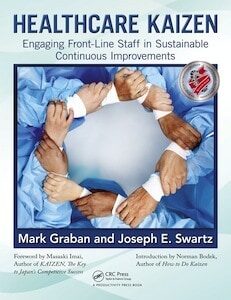Last month, when I was at Franciscan Health in Indianapolis for the “Kaizen Live!” site visit and event there, one phrase really stood out at me as a new development in their approach and culture… or maybe it wasn't new and it just jumped out at me this time.
In the practice of Lean and Kaizen, we often find ourselves focused on:
- Problems
- Waste
- Gaps
- Issues

Whatever words we use, this is often viewed as somewhat negative. Identifying waste or a problem might seem finding fault and that sometimes makes people uncomfortable (although I think that the identification of problems is an inherently optimistic endeavor, because I believe things can be made better).
At Franciscan, they solve a lot problems. They eliminate a lot of waste through Kaizen. They try to engage everybody in improvement. And there's often real joy in that.
But, if solving problems is the only focus, we might miss some opportunities. Can we choose to make things better? Can we identify unmet needs for patients, families, visitors (and staff)?
The phrase I heard a lot was:
“How might we?”
It's a powerful phrase, used in one of two ways.
First, the question asks for ways to push performance in a positive direction. We might be meeting a goal or target for performance, but we could ask, “How might we make patients and families happier with their time here at the hospital?”
How might we delight and surprise people?
Secondly, the phrase can be used as a bit of “can do” spirit when faced with a problem to solve or an opportunity to make things better.
Instead of saying, “Here's why we can't do _________,” we can instead ask “How might we _________?”
Our attendees really took to that phrase.
How might we transform healthcare?
How might we reach zero preventable harm?
How might we create a better workplace culture that results in lower staff turnover and better patient satisfaction and outcomes?
How might we climb that mountain?
I think it's a great phrase… what's your reaction?
Please scroll down (or click) to post a comment. Connect with me on LinkedIn.
If you’re working to build a culture where people feel safe to speak up, solve problems, and improve every day, I’d be glad to help. Let’s talk about how to strengthen Psychological Safety and Continuous Improvement in your organization.









Questions like “How might we…?” trigger our creativity and imagination. They set the mind free to explore possibilities, but only in a certain context.
You can’t generate ideas by straining your muscles or pressing your fingers against your temple. If you try that, you’ll realize your vision gets blurry and your hearing gets fuzzy and you can’t focus. But that’s exactly what we do in “brainstorming” sessions.
The way is to ask your mind a question and then let it alone. Give it the time and space to offer up ideas. Exactly the things not available at work. Can you imagine yourself or anyone else just sitting quietly; not being physically active?
Cheers,
Shrikant Kalegaonkar
You’re right that most workplaces might frown upon “just sitting and thinking.”
There’s a time for thinking, a time for action.
I think Franciscan strikes a good balance… they realize that you don’t know if something is a “good idea” until you go and test it, to see if it works.
Reminds me of a quote I use in my workshops, which I stole from you — a Franciscan nurse manager who said:
Thinking about eliminating waste can be a dispiriting exercise. Thinking about making things better for patients and colleagues is exciting.
I love that quote from them and that sentiment. Thanks for connecting those dots!
Dan, that is a great quote! Do you by chance have the name of the nurse who said it? I would love to use the quote in my next continuous improvement training.
I don’t think that quote was in the book, or I couldn’t find it via a search. It might have been in one of the Franciscan videos I’ve posted? One of the videos with the nurses?
https://www.leanblog.org/tag/franciscan-videos/
But I recognize the quote as something they said… feel free to use the quote and attribute Franciscan St. Francis Health in Indianapolis.
Thank you!
My experience is also that framing things in terms of waste is a non-starter with clinical pros. What worked for me was sitting down with people and saying, ‘Numbers are cold, hard for humans to process, but we have too many instances of of harm, of patients we didn’t help. How do you want to explain this to your co-workers?’ They came up with “Missed Opportunities for Providing the Best Patient Care.” And then they ran with it. Waste is no longer tolerable when it stands in the way of providing best patient care. Right?
That seems like a great way of framing things.
“What gets in the way of providing ideal care to every patient?” is a question I’ve used.
Or we could ask, “How might we provide ideal care to every patient?”
The how might we technique is a well known element in design thinking. You might also be interested in appreciative inquiry, focused on strengths. See for instance the book strength based lean six sigma.
Regards,
Roeland
Yes, here’s more on that from HBR:
The Secret Phrase Top Innovators Use
Great post, Mark.
The words chosen by leaders in an organization can be so powerful. They set the tone for how others think and act.
Part of my Lean training to managers and leaders is that an organization truly begins to shift in a positive direction when you move away from common statement killers like:
We can’t do that because…
That’ll never work here because…
It’s a customer requirement so we can’t…
It’s always been done that way…
To thought-provoking questions like:
Why can’t we…?
What if we…?
How about…?
Could we try..?
When supervisors, leads, and front line workers are unafraid to ask these types of questions, and then given the freedom to explore, experiment, and learn from improvements that they make, then an organization truly is on the right path.
Since I spend most of my time in distribution centers and warehouses, I always ask the site managers if the people that work for them talk this way. If not, why not? How do get them to speak and think differently?
I loved this post, Mark. I recently facilitated a process/service redesign event where we incorporated lean 3P methods with human-centered design. We were working on improving transitions of care from the hospital to the next level of care, focusing on our patients with the most complex needs. I learned the “How might we?” question as part of training through Ideo. I view “How might we?” as more than just a tool or facilitation question–it’s a mindset we all need to make healthcare work for patients and for teams.
Well said. Thanks for your comment, Meredith.
Comments are closed.